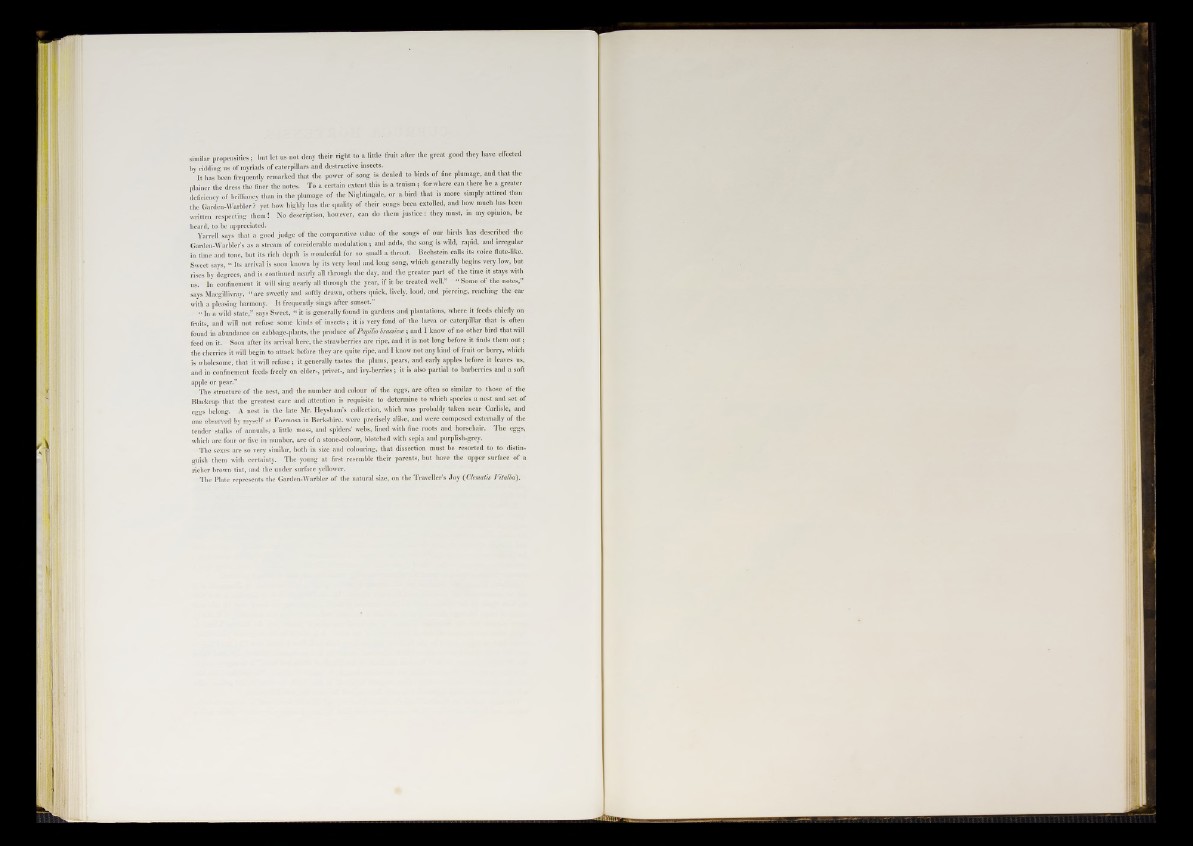
similar propensities; but let as not deny their right to a little fruit after the great good they have effected
by ridding us of myriads of caterpillars and destructive insects.
It has been frequently remarked that the power of song is denied to birds of fine plnmage, and that the
plainer the dress the finer the notes. To a certain extent this is a truism; for where can there be a greater
deficiency of brilliancy than in the plumage of the Nightingale, or a bird that is more simply attired than
the Garden-Warbler ? yet how highly has the quality of their songs been extolled, and how much has been
written respecting them! No description, however, can do them jnstice: they must. In my opinion, he
heard, to he appreciated.
Yarrell says that a good judge of the comparative value of the songs of our birds has described the
Garden-Warbler’s as a stream of considerable modulation; and adds, the song is wild, rapid, and irregular
in time and tone, hut its rich depth is wonderful for so small a throat. Bechstein calls its voice flute-like.
Sweet says, “ Its arrival is soon known by its very load and long song, which generally begins very low, but
rises by degrees, and is continned nearly all through the day, and the greater part of the time it stays with
us. In confinement it will sing nearly all through the year, if It be treated well.” “ Some of the notes,”
says Macgillivray, “ are sweetly and softly drawn, others quiek, lively, loud, and piercing, reaching the ear
with a pleasing harmony. It frequently sings after sunset.”
“ In a wild state,” says Sweet, “ it is generally found in gardens and plantations, where it feeds chiefly on
fruits, and will not refuse some kinds of insects; it is very fond of the larva or caterpillar that is often
found in abundance on cabbage-plants, the produce of Papilio in ttslc a ; and I know of no other bird that will
feed on it. Soon after its arrival here, the strawberries are ripe, and it is not long before it finds them o u t;
the cherries it will begin to attack before they are quite ripe, and I know not any kind of fruit or berry, which
is wholesome, that it will refuse; it generally tastes the plums, pears, and early apples before it leaves us,
and in confinement feeds freely on elder-, privet-, and ivy-berries; it is also partial to barberries and a soft
apple or pear.”
The structure of the nest, and the number and colour of the eggs, are often so similar to those of the
Blackcap that the greatest care and attention is requisite to determine to which species a nest and set of
e*°-s belong. A nest in the late Mr. Heysham’s collection, which was probably taken near Carlisle, and
one observed by myself at Formosa in Berkshire, were precisely alike, and were composed externally of the
tender stalks of annuals, a little moss, and spiders’ webs, lined with fine roots and horsehair. The eggs,
which are four or five in number, are of a stone-colour, blotched with sepia and purplish-grey.
The sexes are so very similar, both in size and colouring, that dissection must be resorted to to distinguish
them with certainty. The young a t first resemble their parents, but have the upper surface of a
richer brown tint, and the under surface yellower.
The Plate represents the Garden-Warbler of the natural size, on the Traveller’s Joy (Clematis Vitalbd).